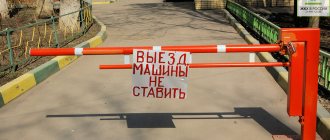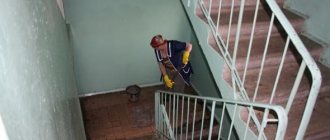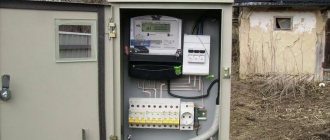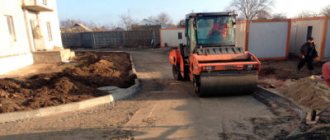The territory cleaning standards for a janitor are not unlimited. In order for the area adjacent to the building to be put in good order, the amount of these square meters should not be overwhelming. But the daily norm of the harvested area should not be small.
When concluding contracts with janitors, employers adhere to certain reasonable amounts of the daily cleaning load.
Legal norms
Legislation to regulate the work of janitors has developed and approved time standards for performing each type of work.
Basically, when preparing the scope of job responsibilities of a janitor, they rely on:
- Order of the State Construction Committee of the Russian Federation dated December 9, 1999 No. 139 “On approval of Recommendations on the standardization of labor for workers involved in the maintenance and repair of housing stock”;
- Resolution of the Ministry of Labor of the Russian Federation dated June 24, 1996 N 38 “On approval of service standards for workers engaged in sanitary maintenance of households”;
- Resolution of the State Construction Committee of the Russian Federation No. 170 dated September 27, 2003 “On approval of the Rules and Standards for the Technical Operation of the Housing Stock.”
The regulations of local self-government regulate not only the general procedure for the maintenance and improvement of the territory of the municipality, but also who should clean the area near a store or catering establishment if they are located in a residential building, whose functions include keeping intra-block passages clean.
Standards for janitors for cleaning the territory: Download for free
You can download for free all the information about cleaning a plot of land that is part of the common property of an apartment building.
Standards of labor and material resources are specified taking into account the requirements of SanPiN and in accordance with GOST. Every janitor should take note of this example document.
Please note that the pictures also show in detail the removal of snow from the territory .
Here is a gallery of 16 pictures. To view them, click on the first picture. The image will open in large size. Next, scroll through the pictures in the usual way (using the mouse or a button on the keyboard). Save the standards to your computer or phone so you always have them at hand.
Territory cleaning standards, page 1
Territory cleaning standards, page 2
Territory cleaning standards, page 3
Territory cleaning standards, page 4
Territory cleaning standards, page 5
Territory cleaning standards, page 6
Territory cleaning standards, page 7
Territory cleaning standards, page 8
Territory cleaning standards, page 9
Territory cleaning standards, page 10
Territory cleaning standards, page 11
Territory cleaning standards, page 12
Territory cleaning standards, page 13
Territory cleaning standards, page 14
Territory cleaning standards, page 15
Territory cleaning standards, page 16
There are several standards governing the cleaning of territories by a janitor. The territorial factor has become averaged.
But in fact, it depends on the characteristics of the site itself and the formations:
- chipping formations of ice and snow;
- dust sweeps;
- clearing snow.
All standards that relate to this type of work were approved a long time ago (more than 20 years ago). They are prescribed in a special Resolution of the Ministry of Labor of the Russian Federation.
Depending on the season
In winter and summer, the list of janitor jobs, as well as the main tool used for cleaning, differ. Accordingly, different standards for the cleaned area have been established. The size of the area is influenced by weather conditions, type of surface covering, intensity of pedestrian flow and other factors.
Breakdown into groups by traffic intensity:
- when traffic is up to 50 people per hour, it is considered first class;
- with a flow of 50-100 pedestrians - the second;
- if more than 100 people move along the sidewalk per hour - third.
Yard sidewalks belong to the first class. Lawn areas are not included in any classifications and are considered separately during standardization.
It is customary to divide sidewalks by type of coating:
- improved (asphalt concrete, paving stones);
- unimproved (crushed stone, cobblestone);
- areas without coverings.
In winter, the standards for the harvested area are lower than in summer.
The method for calculating cleaning standards for a janitor is to add up the standards for each type of work performed in different periods and divide the working time by the result obtained. This results in the area that a worker must clean while following the technology and performing other auxiliary types of work.
Employers take the time standards for cleaning 1 meter of area in various ways and using different tools, for cleaning one trash can, for taking out one bag of garbage, and so on for each type, from the standards developed by government agencies. If necessary, the management of the organization hiring janitors can develop their own standards by timing the entire cleaning cycle.
Summer standards
The janitor's summer cleaning standards consist of sweeping sidewalks, watering and caring for lawns, removing garbage and solid household waste generated in the entrusted territory.
According to the intensity group, first-class pedestrian paths are swept once every two to three days, the rest are swept once or twice a day.
When calculating the load on a janitor in the summer, the following are taken into account:
- daily cleaning of waste bins with morning rinsing;
- removal of collected waste to containers or garbage bins;
- organizing bulky garbage and waste at a special site;
- collecting fallen leaves and removing them to containers or to a special area;
- watering asphalt in hot weather.
In winter time
The main task of a janitor in winter is to remove ice and snow and sprinkle icy paths with sand or chemicals.
Accordingly, on first-class pedestrian paths, snow removal is carried out once every three days, on the rest - they are removed daily or every other day. When fresh snow falls, cleaning is carried out immediately, regardless of the surface of the sidewalks or the intensity of pedestrian traffic.
Loose, recently fallen snow in a layer of up to 2 cm is swept with a broom, and over 2 cm is moved using a wide scraper or snow shovel. The winter season and snowfall do not relieve the janitor of the responsibility for collecting garbage, which must be taken into account in winter standards.
Payment Responsibilities
The adjacent territory is the common property of all residents living in the relevant building. This is stated in Article 16 of Federal Law No. 189, which enacted the Housing Code of the Russian Federation on March 1, 2005. The location of the apartment building means that all owners of the premises will use the adjacent plot. For this reason, each of them is required to pay. The amount is determined based on the area of the apartment owned by the resident. That is, the more square meters a person owns, the higher his payment will be.
What work needs to be done
The work required by a janitor is specified in his job description or in the employment contract. Time periods for carrying out cleaning activities are established so as not to create inconvenience to citizens.
Responsibilities of a janitor for cleaning the local area:
- maintaining the cleanliness of the areas adjacent to the building;
- cleaning sidewalks, removing dust, sand, snow, ice, debris;
- watering sidewalks in the summer and sprinkling sand in the winter;
- keeping fire and storm water wells and drains clean;
- ensuring the safety of plants and grass cover in the entrusted territory;
- maintenance of fences and fences;
- cleaning and washing trash cans;
- cleaning cornices and drainage pipes;
- timely informing management about violations;
- cleaning of children's and sports grounds, if available;
- cleaning areas for garbage containers, assisting in unloading them if necessary.
The list is far from complete and in each specific case can be expanded or reduced by the employer depending on needs and volumes.
What is considered a local area?
Each residential building has an adjacent plot of land nearby. It is considered inalienable and is not considered in a legal sense as a separable entity. The name of this site is the adjacent territory of an apartment building. Let's list what it includes:
- the land on which the residential building is located;
- children's and sports ground;
- parking lot;
- fire passage;
- green spaces;
- other infrastructure and development elements.
Thus, on this site there are various facilities that residents can equally use. The area of the territory, its boundaries and other parameters are determined by the cadastral passport. Based on this data, the cost of cleaning the site is calculated.
By type
Work on cleaning the territory is carried out manually or using sidewalk cleaning, sweeping and watering machines, while places inaccessible to equipment are cleaned manually. Machines and mechanisms can be either self-propelled or mounted.
When manually cleaning an area in different seasons, the following basic tools are used:
- in winter, brooms, shovels, scrapers (motors), crowbars, and small-scale mechanization equipment are used;
- In the summer, brooms, shovels, rakes, trimmers, watering hoses and small-scale mechanization equipment are used.
When mechanized cleaning of territories, special equipment of various models and modifications is used with installed special equipment to perform work depending on the periods.
Manual cleaning
Manual cleaning is labor-intensive, but less noisy and allows you to prepare the sidewalk for the mass movement of pedestrians during hours when citizens are still resting or just beginning to prepare to leave.
When manually removing snow from improved surfaces, the snow is removed completely, using a scraper or shovel; from unimproved surfaces and areas without coverage, snow is removed to the maximum extent possible, with some of it remaining for compaction. Snow from sidewalks moves onto the roadway or collects in banks on lawns, if possible, in specially designated free areas. The sand sprinkled on the paths should be river sand - medium or coarse-grained.
In the spring, janitors need to clean the grooves for draining melt water and the covers of storm wells from accumulating dirt that interferes with the flow of water. When the snow finally melts and the area dries out, the wipers clean off all the sand that has accumulated over the winter from the asphalt. In summer, the main task is to sweep and collect scattered garbage. Sidewalks are washed towards the roadway before the cleaning equipment exits. In the fall, nature throws its share of garbage at the janitors, throwing leaves from the trees.
Work is carried out in the early morning or late evening hours.
Mechanized
Winter cleaning of yard areas can be done not only manually, but also using machinery. When using harvesting machines, snow up to 2 cm high is removed with brushes, with a greater layer depth - with a scraper and brush. Snow piles are collected along the roadway, in courtyards at designated storage areas. Manual loading of snow onto transport vehicles may be required for removal.
Mechanical cleaning is different:
- speed;
- efficiency;
- profitability.
Despite all the attractiveness of cleaning with technology, there are still some nuances that can only be dealt with manually. Not every home or even a management company that manages several homes can afford equipment. The equipment cannot clean all areas at the same time. There remain places that cars cannot reach, and technological gaps. Machines make noise when operating, so they try to use them to clean local areas during the daytime.
However, there are areas that can only be cleaned with machinery, for example, long driveways and sidewalks more than 3.5 m wide.
Snow removal standards for a janitor
If we are talking about clearing the territory of snow, then the numbers will look different. So, to clean up precipitation that has just fallen, the following is allocated:
- 0.14 min. – for a site with improved coverage;
- 0.17 min. – with unimproved coating;
- 0.21 min. - without cover.
Again, these indicators are calculated for class 1 territory.
Above you saw the standards for cleaning common areas. They also included snow removal. Next, we invite you to familiarize yourself with more detailed (enlarged) standards for labor and material resources for snow removal. See picture below.
Snow removal standards for a janitor
Who controls
The work of the janitor is controlled by an employee of the HOA that hired the employee, the management organization, or a representative chosen by the citizens who own the residential premises of the apartment building. If part of the house is owned by a store, catering outlet, office or service enterprise, then the administration of these establishments is obliged to monitor the cleaning of the adjacent territory.
Accordingly, the cleaning of the area near the apartment building is directly monitored by the residents themselves and they contact the management of the management company, the HOA, the house manager, the management of enterprises and organizations located in the building with comments and complaints.
Control is also exercised by local government bodies and government organizations created to protect the interests of property owners’ rights and environmental protection. In case of non-compliance with the rules for the maintenance and improvement of territories, lack of response to requests from the population, organizations and officials who committed violations are subject to administrative penalties.
Whose responsibilities include
Issues of maintaining the common property of an apartment building are regulated by the Rules, which came into force on August 13, 2006. According to their provisions, cleaning of the adjacent territory is carried out by the management company, whose responsibilities include maintaining a specific building. If the house has a homeowners association, then they independently enter into an agreement with a third-party organization that provides the relevant services. In this case, said company will be held liable for failure to perform cleaning duties.
Pay level
Employers set wages or payment for janitor services for the scope of work established by the contract and performance of official duties in accordance with standards independently to the best of their financial capabilities.
But it should not be less than the established minimum level if the daily cleaning rate requires a full working day.
If the area to be cleaned is smaller or larger, then wages are usually set proportionally. In organizations that apply qualification rules when rationing labor and setting wage levels, the pay for janitors is set at the rate of the first category of workers, that is, the lowest level.
To materially stimulate the work of workers involved in cleaning the territory, a bonus system can be used, providing additional remuneration provided that the standards for servicing the entrusted area are met.
Legislative regulation
At the moment, mainly 2 federal acts are used to review cleaning standards.
In this document, the standard is determined by the time that a janitor should spend as much as possible on cleaning 1 square meter of a particular area. For example, in the case of sweeping, the norm (in fractions of a minute) looks like this.
And if we are talking about cleaning the area from freshly fallen snow, then the following standards are established for the janitor.
Similar tables are presented in the Resolution of the Ministry of Labor, which was adopted back in 1996.
For example, in the case of sweeping freshly fallen snow, the table looks like this.
And if we are talking about ordinary sweeping of debris, dust, soil, leaves, etc., the standards are as follows.
In practice, standards for cleaning the territory are also prescribed in documents at the local level - for example, for janitors in the city of Moscow who work in educational organizations, such requirements are provided.
It is important to understand that the standards in each case are established by a specific organization, but they cannot contradict the norms of federal legislation. The employee must find out such information before signing an employment contract. As a rule, the table of norms is given:
- in the annex to the individual and/or collective labor contract;
- in the job description;
- in other internal documents.
Expert opinion
Salomatov Sergey
Real estate expert
The company can independently change the standards. However, the employer must warn the employee about this in writing at least 2 months before the new requirements come into force. This is directly stated in the Labor Code (Article 162).
Payment order
It was noted above that cleaning of the area adjacent to the house is paid for by the homeowners (for this, there is a separate column in the receipt for utility bills). All of them, to one degree or another, use the land.
Some people park their cars near their house, others walk on the playground with their children, others get aesthetic pleasure by planting beautiful flower beds under their windows, etc.
The Housing Code of the Russian Federation clearly states the procedure for calculating tariffs for servicing land owned by residents of high-rise buildings. As noted earlier, the bill will depend on the area occupied by the owner's apartment.
If the residents of an apartment building regularly pay their payment receipts, but no one comes to clean, or the work is carried out in an insufficient amount and volume, the neighbors have the right to contact the service company with a request to reduce the fee for poor-quality services.
In the complaint, you must note all the necessary information, detailing the description of the uncompleted work.
Actions if cleaning is not carried out
If employees of the housing and communal services or the organization with which the contract is concluded do not perform all the desired work, residents can write a complaint. You can view the template online, as it is publicly available.
You need to send a complaint:
- to the head of the HOA;
- to the chairman of housing and communal services;
- to the housing inspection;
- to the administration at the place of residence;
- to court;
- to the prosecutor's office.
The report must include the main facts of violation of cleaning rules. The document must contain:
- Name;
- the essence of the complaint (clearly state what work was not performed);
- details and name of the company that performs the work;
- Full name and signatures of the people writing the claim;
- exact residential address, including apartment number.
Afterwards, you need to write a statement, which implies the need to recalculate the prescribed obligations. If desired, residents can terminate the contract with the contractor and choose another organization. When you select a company, consider its reputation and reliability.
Now you know that the cleaning of the local area is carried out by a certain company, with which you need to conclude an agreement in advance. If any claims arise, you can refuse its services and choose another contractor. However, remember that the residents of the house must pay for the work of the cleaners every month.
Useful articles on the site:
- Do I need to add water and sugar to homemade grape wine?
- What products and how much should you buy for a home banquet?
- Games for fun at home
- How does childbirth go?
- What you need to do before the New Year










